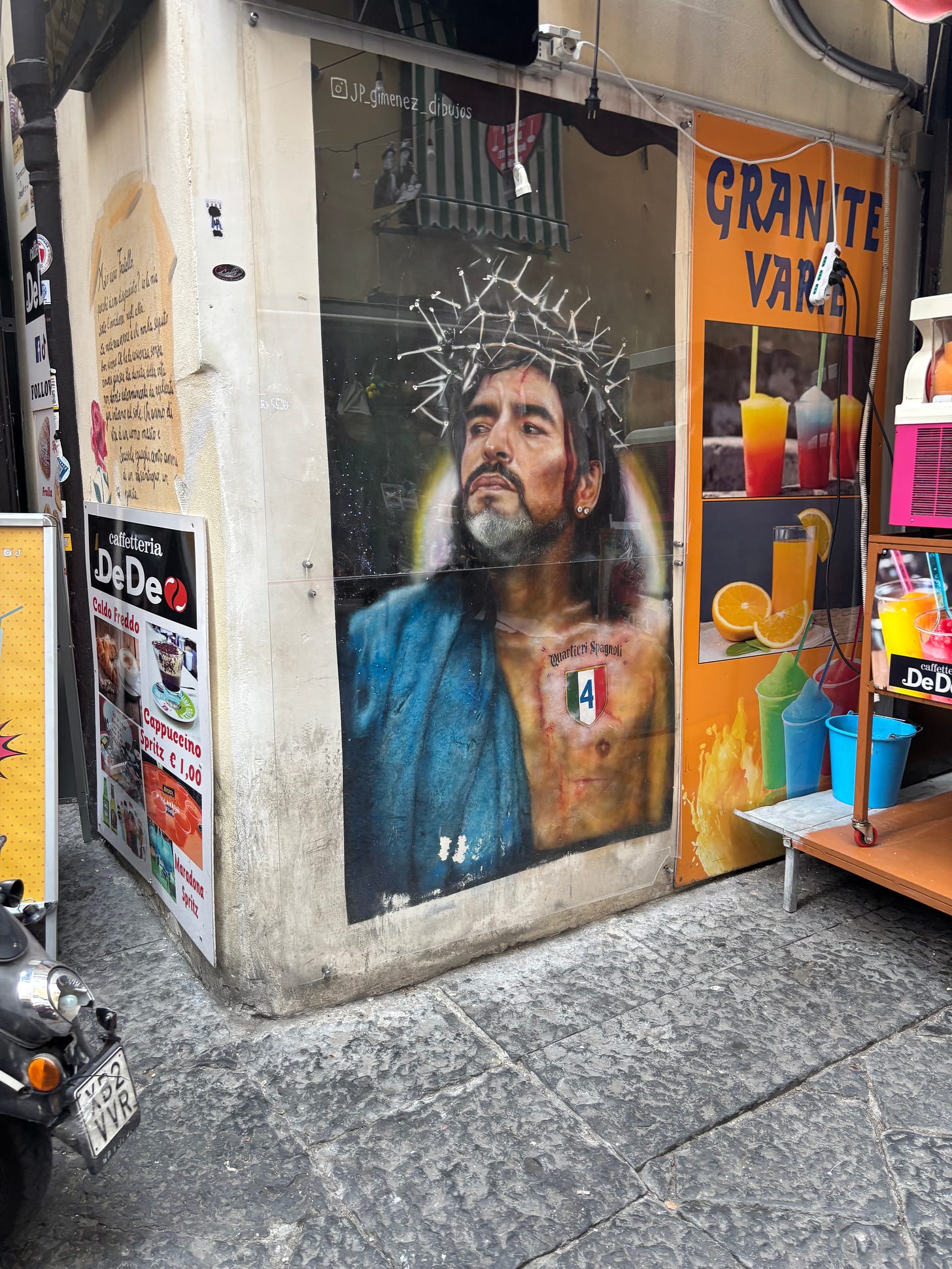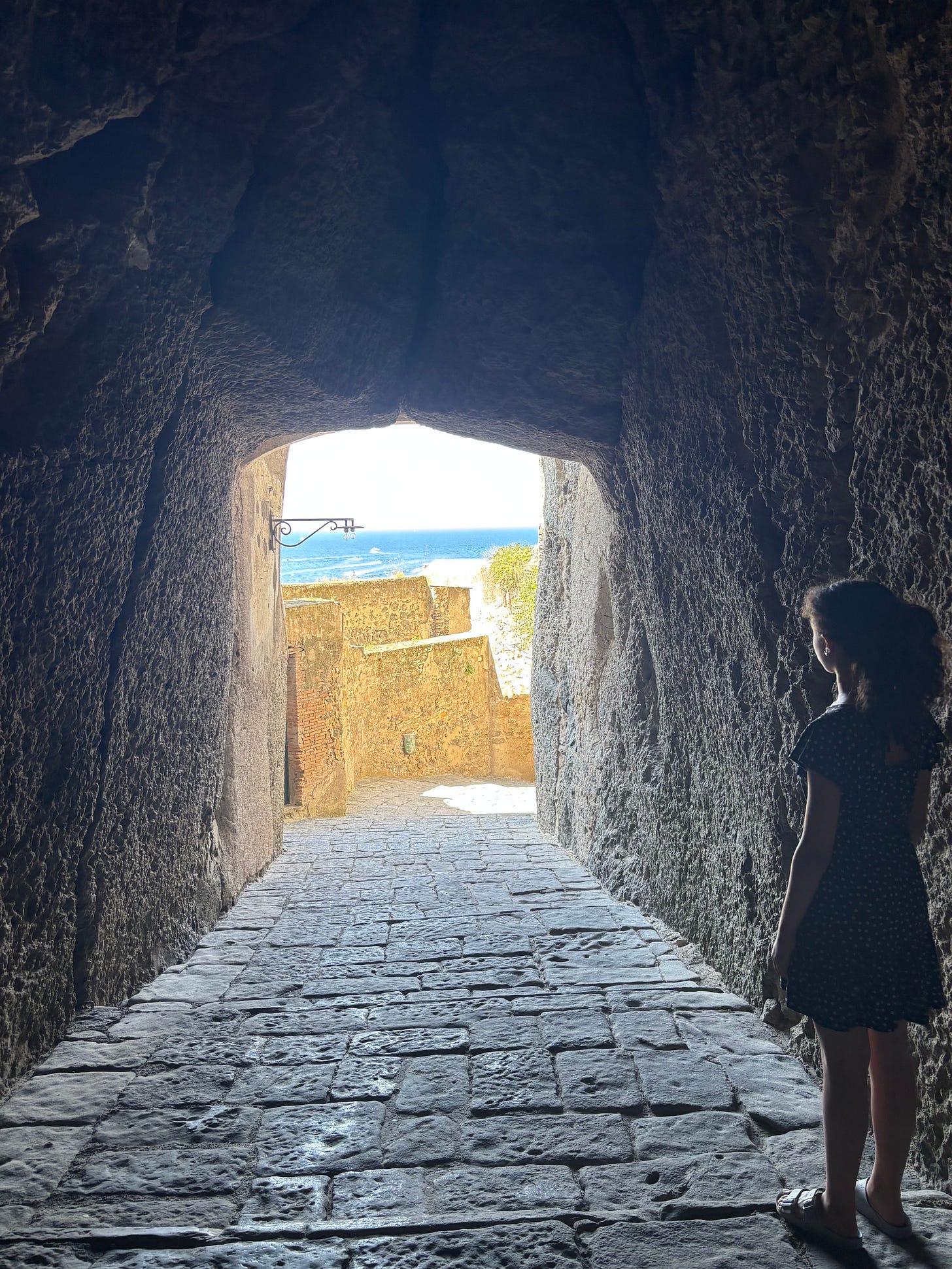Napoli, like all great cities, is more than one thing. While the stereotype of the south of Italy—il mezzogiorno, the land of the midday sun—is one of carefree sunny days, the reality of Napoli is a contrast of light and dark, of depth as much as the heights of its vistas—like Vesuvius, at once pinnacle and an opening into unfathomable depths. It is like asking what a great book is “about.” It could never be about a single thing, a single story. Napoli is a story of many things. A story of Greeks and Romans, Arabs and Italians. It is wandering the noisy and labyrinthine streets of the Spanish Quarter and relaxing at the bookstores and cafes next to Greek ruins in Piazza Bellini.
We traveled together, a family of five, to Italy, especially to the south, to celebrate twenty years of marriage by returning to the place where we’d honeymooned. We wanted to show our children places that had been meaningful to us, but also to show them something else of the world, especially in Napoli, the city of (some of) their ancestors. What’s more, a city of texture, of those dimensions of life—of depth and of struggling, of darkness and light commingling—that many of us have lost in our sterile, two-dimensional, well-lit lives. In recent years I’d left behind my life as a traveler to witness the adventure that is childhood. And now, as my daughters grew into adolescence, I wanted them to see another part of their world, of life.
We stayed in the Spanish Quarter. Its reputation is that it's a bit unsavory, but we found it welcoming. Still, our oldest wondered why we’d chosen to stay there. Isn’t the point of a vacation to stay somewhere nicer than home? she mused. The images of Maradona were everywhere in the Spanish Quarter, something like a patron saint, befitting this beautiful and flawed place: once the world’s greatest footballer and champion of the downtrodden, he’d chosen to play for Napoli, a team that had never won anything until he’d come there. His shortcomings—his addictions and connections to organized crime, for example—seem only to make him more beloved here.
The reverence for Maradona makes sense only if one understands the Neapolitan religious sensibility. Its layers of history give rise to a syncretic culture as much pagan as Catholic. And daily spiritual life there largely emphasizes the intercession of the spiritual world in the mundane. There is more emphasis on asking the gods and saints for help in winning the lottery or a soccer match than on the eternal salvation preached by the Vatican to the north.
From Napoli we took a trip to Sorrento and the ruins of Pompeii. There, I briefly reunited with my old friend Sergio, from nearby Ischia. His boat was moored near Pompeii. We’d met in Tibet many years ago and traveled across the Himalayas together. Ours is a friendship of singular experience, of the connection made—nearly unbreakable—of two young men traveling the world in difficult and remote places, experiences that shaped us. The past we shared was one of the heights of the Himalayas, of wandering through ruins, like Pompeii. How different—and how much harder, I mused—to travel with a family than even under the circumstances in which we used to travel. In comparison, I laughed as I told him, “L’Himalaya e’ facile.”
After twenty years, you know that traveling across the Himalayas is nothing compared to raising a family. You learn to appreciate both the ruins as well as the messy work to repair. And traveling with a family is like excavating ruins: past hurts are still there, like crumbling Greek walls in the middle of a beautiful piazza, reminding us of who we were and are. The art of repair isn’t about restoring the wall, but about witnessing it and building new lives around it. In this way, Piazza Bellini is more informative than Pompeii.
Still, there is something magical about wandering through ruins. We are all, like the Neapolitans, made up of layers upon layers of past selves, still present and alive if we are aware enough, brave enough, to excavate. In Napoli, excavation is unavoidable; life is a daily process of both sifting through the ruins and the work to rebuild and repair. Its ruins are shared, like a family, constantly in a state of despair and repair. It was a bit cramped and crowded for my girls—they preferred Ischia, its brilliant blue sea, its clean and quiet streets. But Napoli is like life, like family. Messy.
We took a train from Pompeii to Sorrento, which is beautiful if a bit boring, and then made our way to Ischia. We were hoping that something there would connect our children to how they came to be, how, many years ago, their parents fell in love and made a family together. They loved it—it’s perhaps a bit more obvious here on this sunny isle than in the Spanish Quarter.
My youngest child often breaks things. She’s gifted in ways that are called “divergent.” And in the process, she’s taught me this: Things—and people—break. Sometimes, for example, your teenage daughter breaks down in tears on a ferry in the Bay of Naples and you cannot give her comfort or fix her problems or make life less messy. And then an old woman hands you a napkin saying to your daughter and to you, “Non piangere. Perché lei sta piangendo?” The tiny napkin, like your words, is so utterly insufficient, but you realize then and there that there really isn’t a napkin big enough to wipe away all the tears. Even a shimmering sun-drenched sea, here in south of Italy, il mezzogiorno, the land of the midday sun, isn’t bright enough to make life’s dark times go away.
The ferry takes us back to Napoli from Ischia. There, the sun still shines, but the streets of the Spanish Quarter are crowded, dirty and dark. It is perhaps not as happy there as in Sorrento. But it is more joyful. We think that our purpose is to make it always bright and sunny, to numb the pain, to fix the broken things. But repair is something different. Repair is the antidote to despair. We can find it in the contrast of light and dark in the Neapolitan streets. Like my baby girl, it is a place that teaches us that not all broken things can be fixed, but if we don’t turn away from each other, there remains the possibility of repair.









Bravo, Theodore- creating family is an adventure like no other…. Tolstoy long ago dispelled the myth of “happy” families but too many of us still seek the Cosby dream instead of leaning into the beautiful mess… the gift of repair